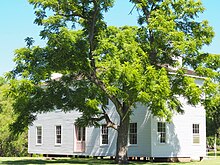Levi Jordan Plantation State Historic Site
The Levi Jordan Plantation is a historical site and building, located on Farm to Market Road 521, 4 miles (6.4 km) southwest of the city of Brazoria, in the U.S. state of Texas.
Founded as a forced-labor farm worked by enslaved Black people, it was one of the largest sugar and cotton producing plantations in Texas during the mid-19th century, as well as a local center of human trafficking.
[3] Previously, Jordan had owned adjoining plantations on the Louisiana-Arkansas border (Union County, Arkansas) with his son-in-law, James Campbell McNeill,[2] however he was not as successful as he wanted to be.
He also traveled to Louisiana, where Jordan’s daughter Emily, his son-in-law James Campbell McNeil, and his grandchildren resided, to sell that land so they could all pack up and move to Texas.
[5] Jordan's enslaved workers hand-hewed the window sills and studs of the house from local oak lumber and they handmade bricks for the fireplaces.
[9] The cabins no longer physically exist as buildings, however through archaeological excavation researchers were able to find many of the remnants of former workers and piece together a better understanding of their history.
[10][9] The Levi Jordan Plantation Historical Society, a local advocacy group and 501(c)3 organization, was created in 1993,[11] and its membership includes site descendants and other community members.

